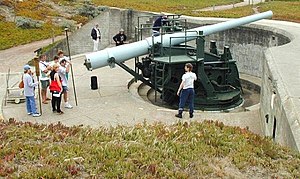| 6-inch gun M1900 | |
|---|---|
 6-inch gun M1905 on disappearing carriage M1903, Battery Chamberlin, Fort Winfield Scott, Presidio of San Francisco | |
| Type |
|
| Place of origin | United States |
| Service history | |
| In service | 1897–1945 |
| Used by | United States Army |
| Wars | World War I, World War II |
| Production history | |
| Designer | Watervliet Arsenal |
| Designed | 1897 |
| Manufacturer | Watervliet Arsenal, possibly others |
| Variants | M1897, M1900, M1903, M1905, M1908, M1 (a.k.a. T2) |
| Specifications | |
| Mass | 19,114 pounds (8,670 kg) |
| Length | 310.4 inches (788 cm) |
| Barrel length | |
| Shell | separate loading, 108 pounds (49 kg) or 105 pounds (48 kg) AP shot & shell, 90 pounds (41 kg) HE[1][2] |
| Caliber | 6 inch (152 mm) |
| Breech | Interrupted screw, De Bange type |
| Recoil | Hydro-spring |
| Carriage |
|
| Elevation |
|
| Traverse |
|
| Maximum firing range |
|
| Feed system | hand |
The 6-inch gun M1897 (152 mm) and its variants the M1900, M1903, M1905, M1908, and M1 (a.k.a. T2) were coastal artillery pieces installed to defend major American seaports between 1897 and 1945. For most of their history they were operated by the United States Army Coast Artillery Corps. They were installed on disappearing carriages or pedestal (a.k.a. barbette) mountings, and during World War II many were remounted on shielded barbette carriages.[4] Most of the weapons not in the Philippines were scrapped within a few years after World War II.
- ^ a b Berhow, p. 61
- ^ TM 9-424, pp. 3-4
- ^ Berhow, pp. 94-105
- ^ Coast Defense Study Group fort and battery list